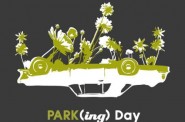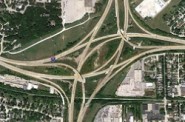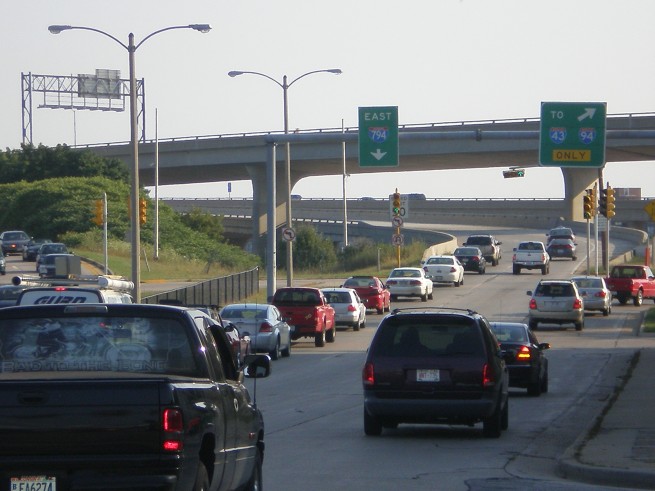Freedom Brought to You by the American Auto Industry, Hello Officer, Put the Phone Down, and More
Welcome to the first installment of Car Culture. It will be a place for us to talk, think, and explore our addiction to the automobile. Don’t fear, it’s not about how much I hate cars, and isn’t about forcing you to take the bus or ‘worse’ yet ride your bike. It is about understanding the history of our love affair with the automobile, and its true costs and consequences. Often forgotten or hidden away is that the rise of car culture has had devastating impacts on the built environment, the natural environment, and our society.
We’ll start off with a little trip down memory lane to see how we came to believe that the car is freedom. Then we’ll talk about two ridiculous crashes, and learn about distracted driving. Additionally, each week there will be the regular features of Dangerous Roads, Loosening Our Belt to Cure Obesity, and Tweet of the Week.
Freedom Brought to You by the American Auto Industry
U.S. automakers successfully sold the American public that access to an automobile is “freedom”, and that an automobile is an inalienable right, not a responsibility. For decades millions of dollars have been spent marketing this concept to us. It is so ingrained in our belief system that I’ve actually had friends tell me ‘my car is freedom’. Yes, marketing works. I’ve included just a two of the numerous examples where U.S. automakers have tied your freedom, to the car, sometimes quietly and other times they come right out and say it.
“Why be stuck with one expensive car when you can enjoy all the fun, and freedom of two Fords”, questions the speaker for Ford Motor company in this commercial from the 50’s.
This one from Dodge in 2010 continues the tradition while drawing a direct line from freedom, in fact the Revolution, to the automobile.
http://youtu.be/JMRMW1FXSHw
So don’t confuse by what we’ve been sold, a bill of goods, and what is actually true, freedom certainly doesn’t require a car.
Hello Officer
You’d expect that crashing your car into a police car was a rare event, apparently not as this happened twice during the month of April in Wisconsin. I suppose crashing your car into a squad car is essentially the same as smashing into any regular citizen’s car, but talk about ‘distracted’ driving. Please folks, don’t drive into the flashing lights.
Put the Phone Down
Dangerous Roads
- Unlicensed driver charged in crash that killed Milwaukee boy
- Student struck by vehicle near Wadewitz Elementary School
- Germantown police find body in submerged vehicle
- Man seriously injured in crash; I-894 lanes closed
- CAUGHT ON CAM: Car drives through pizza shop
- 17-year-old arrested for OWI with minor passengers
- Two arrested over the weekend for fourth OWI in separate incidents
- 44-year-old Sturtevant woman arrested for sixth OWI
Loosening Our Belt to Cure Obesity
Tweet of the Week
Why is it that divorced men are more Iikely to meet their car payments than their child support obligations?
— ILLUMINATI (@ILLUMlNATI) April 23, 2012
Car Culture
-
It’s PARK(ing) Day, Let the Celebration Begin
 Sep 20th, 2013 by Jeramey Jannene
Sep 20th, 2013 by Jeramey Jannene
-
Why WisDOT Is Behind the Times
 Jun 12th, 2013 by Dave Reid
Jun 12th, 2013 by Dave Reid
-
Walker’s Massive Borrowing Scheme
Feb 19th, 2013 by Dave Reid























Thanks Dave, this should prove to be an interesting series. I’d like to add to your section on distracted driving. The whole concept of “driving” i believe has changed dramatically in the past few decades. Now with GPS, lane departure warning systems, collision avoidance systems, airbags, adaptive cruise control, huge SUVs, and 95%+ of cars having automatic transmissions, most drivers no longer think very much about the actual act of driving… it’s no longer engaging to them. It’s no wonder teenagers have been reported to think of driving as “boring” and don’t feel there is much harm in being on the phone or texting while driving.
It has been (jokingly) said that everyone would drive much better if we put a big spike in the middle of everyone’s steering wheel…
@gavin No doubbt… More than once I’ve been riding in a car and have reminded the driver, put the technology down. Be in the gps, ipad, er whatever, it seems that to some actually driving has become the secondary task instead of the primary task when driving!
The general population is not addicted to the automobile — the auto industry is — that’s a very different situation.
Infrastructure is destiny. Allow people to walk and bike, and they will — it’s that simple.
When we talk about our addiction to automobiles, we have to include the enablers. Than main enabler to auto addiction is the automobile industry. By making the use of an automobile a life style statement rather than a function, we take the automobile from being a convenient way to travel to a badge of who we think we are and what we want to tell other people we are.
Engineers talk about “fitness for use”. Define the usefulness of a machine or process and buy the best you can afford. (Think tools for house hold repairs or a vacuum cleaner.)
When we buy a car, we often buy a model with features we’ll never use because of what I call the national park dream. I probably never go to Yellowstone National Park, but I like to think I can, if I ever want too. So we buy off-road capable SUV’s when statistically we will never leave the asphalt / concrete roads we insist on. My favorite is the Cadillac commercial that offers windshield wipers tested to work at 160 mph. Where and when would I need that? I’m not in the habit of driving during a hurricane. The color, style and features of our car tell people what we think our status is. In realty, a car is a very expensive suit of clothes
So they make it up and we eat it up. Don’t blame them if we get drunk on this fantasy, they’re just the bartenders.
As I looked at the stunned and despondent expression on my neighbor’s face when he realized that his car’s battery was dead, i was reminded once again that cars don’t grant freedom; rather, they breed dependence. He works a mile and a half away, but could not imagine traveling without the car. He was, in effect his servant’s slave.
If you want to read more about how the car was systematically associated with “freedom” and other national identity constructs, i recommend looking at Cotton Seiler’s excellent book, “Republic of Drivers.” I have published a brief review of it at Sustainable City News. See it here: http://www.sustainablecitynews.com/br-repdriv.html
@Rick Exactly.
@Peter Oh I fully believe it is a two-way street.
@Jeff Clearly the Auto makers are one of the big enablers, but there are others which we’ll get to.
Our society has turned into a bunch of babies. When planning an event for my job, a lot of thought and effort has to be given to parking, helping people find parking, holding people’s hands to help them find their parking, reassuring people about the parking, etc. If there is not a place to park within one block people will not come. People are surprised when I show up to a meeting on foot, even though I walked a mere four blocks to get there.
I was at an event at the Marquette Law School recently, for which all of the participants were granted “free parking” in the underground structure. The organizer told me that the Law school students and faculty were upset because they lost “their” parking spots and had to park in a structure two blocks away. So this is what our society has come to?
How ironic that America, land of the free, has become so utterly dependent on one transport method. Cars do not make us free, they enslave us.
The thing is, cars have an important role to play. Thanks to the car I am able to visit far flung places around the State with regularity. I am able to make a visit to Ikea to buy crappy furniture. So, cars are necessary and important, for many everyday tasks.
But why, in order to get to my place of employment, or to run out and get some baby formula, must I set fire to a fossil fuel that has been mined and transported from the other side of the planet, processed and used to transport a two-ton hunk of steel, all to carry a 150 pound passenger and a 12 ounce canister of baby formula?
But of course I’m preaching to the choir here. How do we get most people, those who don’t really think about this stuff, to choose a more sane method to run to the library or the bank?
The auto industry and post WWII government policy that seems to continue today. It’s all about new construction on virgin land. Now the rest of the world’s developing nations want to make the same mistakes we have. Everyone wants their own cracker box house and a Ford Ranch Wagon…
@Gomez No doubt the government played er plays a big role in this… and I will touch on that topic as well in the future.
@Dave Steele No doubt…
@Dave Steele Couldn’t agree more.
The production and use of the automobile is bittersweet. The impact on the economy and overall quality of life has been immense throughout history. The problem? Not using this technology responsibly and thoughtfully. Add to that all of the solutions for reducing car usage squashed by those in positions of power.
And GM paid an embarrassing, irrelevant, $5000 penalty In 1951 for conspiracy to buy and dismantle cities’ street car and light rail systems to replace them with buses.
Oh my, there’s that “GM destroyed our streetcar and light rail systems” accusation again. GM (and its allies) didn’t help matters any, but the disappearance of electric railways is a much more complex story than just the National City Lines saga. For example, San Francisco’s Municipal Railway didn’t buy a GM bus until 1969, yet by 1958, they had eliminated all but five streetcar lines, and of those, four ran through tunnels too tight for bus operation. One factor that was in place until 1954 was a city ordinance requiring two-person crews on streetcars, but allowing driver-only operation on buses. Another factor throughout the country was worn-out track and overhead. By the 1940’s many lines that had been built in the 1900’s were “showing their age”, but so many former trolley riders had bought automobiles that the railway companies didn’t have the money or credit to rebuild the tracks and wires, but could buy buses with favorable financing terms. One writer pointed out that the very ruggedness of trolley cars was a weakness; for example, as late as 1947, both Pacific Electric and LA Transit Lines were still using cars that were built about the same time that Henry Ford introduced the Model T.
Our dependence on cars was/is often exasperated by city and regional planning which made it easier to build new houses and office parks outside of city centers instead of downtown where they would be accessible by different modes of transportation. People forget that roads are part of the “public right of way” and to be used by everyone no matter their income level or lifestyle.
Are you going to be touching on the public health ramifications automobile dependence has cause our society?
Just wanted to point out that the second article linked under “Dangerous Roads” describes a child hitting a car, not a car hitting a child. (Vehicle drivers need to watch out for children running into their cars!! It’s dangerous out there!)
@Brent I’m sure I’ll bring up the Health issues from time to time as well.
@Liz H Yeah I see that now, but don’t worry I’ll have plenty of material on dangerous roads.
What makes these ads particularly cruel (and effective) is that automobile ownership does seem to enhance freedom at first. That 50’s family really will be able to travel around more freely with a second car than with the first. However, over time, infrastructure and land use simply adjusts itself. Call it homeostasis of freedom. The places you go move further away from each other. More people seek out the elusive freedom of the open road and it starts to clog up. Massive public investment is made to unclog it, pushing development further away and mandating car ownership and more driving ever more strictly. Cycle continues.
This 50’s housewife soon finds herself with no more freedom than she had in the first place – only with a car payment and gas expenses. The public is left to pick up the rest of the tab. The poor and vulnerable, who cannot play this game and are not featured on the ads, are left out entirely.
Daniel,
Add to this the then, new need for the wife to get a job to help “make ends meet”. That just adds the extra expense of work wardrobe, added commuting cost and the very expensive cost of daycare. In the best of cases it is a net sum =0 but usually the final tally is a loss.
American driving is sometimes more about driving to get away from places than it is to get to someplace.
The “freedom” these commercials evoke is an illusion based on, quite simply, an exchange of the urban for the suburban (the 1955 commercial) and the power of the car to express anger about–ironically–increasing car-dependence (the 2010 commercial).
The slight-of-hand works very quickly in the first commercial–the woman says “… because we live in the suburbs…” and then recites the long list of problems that entails (isolation, lack of ability to get to events and places, etc). It shifts the argument from the sanity of the original choice (to move away from walkable places to life in the burbs) to solving the problems inherent in that choice (which are conveniently solved by use of the advertiser’s products and government subsidies for roads and cheap gas).
The 2010 commercial is somewhat more disturbing. The fantasy of cars coming onto an American Revolutionary battlefield is the premise. This commercial’s power slowly builds as you see the vulnerable people (Europeans!) on foot scramble. To me, this commercial embodies the fantasy of suburbanites who are frustrated by their car-dependence (although they may not be able to articulate this, they definitely feel it–it literally is a tyranny over their lives). The car-dependent people no doubt would like to take out their anger on someone or something. The smug people who walk are a target (after all, they want to “force” everyone out of cars!). You can see this anger play out every day in automobiles speeding along streets, ignoring pedestrians in crosswalks, and the drivers clamoring for still more free parking and cheap gas. The interesting thing is that this commercial is based on anger–and the anger is directed toward people who are walking (and not buying the advertiser’s products or extending support for car-dependence).
Looking forward to more in this series!
Oh my, there’s that “GM destroyed our streetcar and light rail systems” accusation again. GM (and its allies) didn’t help matters any
Interesting. Let’s see:
Harper’s Magazine, February 1981: The Great Transportation Conspiracy
http://harpers.org/archive/1981/02/page/0016
Yes, I guess it’s fair to say that GM’s grievous acts didn’t kill off public transit on their own — that they merely “didn’t help matters any.”
Similarly, I supposed it’s fair to say that the invading Brits’ grievous acts (giving smallpox-tainted blankets to Native Americans) didn’t kill off the majority of the Native American population on their own — that they merely “didn’t help matters any.”
We also need to address the issue of affordability. Because, frankly, if one has to take out a loan from our debt-enslavers to purchase a car, then he simply cannot afford it. I think the credit industry has skewed the average American’s notion of what is affordable and what is not.